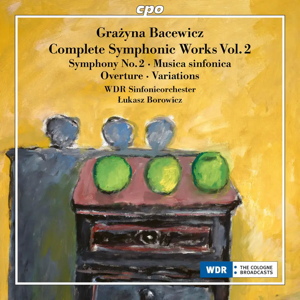
Grażyna Bacewicz (1909-1969)
Complete Orchestral Works Volume 2
Overture (1943)
Symphony No.2 (1951)
Variations for Orchestra (1957)
Musica sinfonica in tre movimenti (1965)
WDR Symphony Orchestra/Łukasz Borowicz
rec. 2023, Cologne Philharmonie, Cologne, Germany
cpo 555 660-2 [53]
The first volume in this series (review) focused on the Bacewicz’s Third and Fourth Symphonies composed between the compressed time period of 1952-53. This second volume spreads its compositional net wider spanning the early – and, for Bacewicz, enduringly popular – Overture of 1943 to the late style embodied in Musica sinfonica (1965). At the helm once again is Łukasz Borowicz who has been as devoted to the composer on disc as had been his eminent predecessor Witold Rowicki in the concert hall.
The Overture for orchestra is on a par with Panufnik’s Tragic Overture and Lutosławski Overture for Strings. Its neo-classicism is clear but so too is its vitality and energy, its resonant percussion and opportunities for moto perpetuo strings. After a brief and bustling introduction of just a minute in length, the music suddenly turns expressively intimate before hustling back to the incident-packed and colourfully orchestrated initial music.
Symphony No.2 followed eight years later in 1951 and was dedicated to, and premiered by, Rowicki. There are four conventional movements, tightly constructed and again broadly neo-classical with elements of impressionism and even neo-romanticism in the slow movement. Bacewicz often motors her symphony via accelerandi and it’s this hustling spirit that’s most apparent on the opening movement. The Lento enshrines some rich yearning, not least from the strings, before she unleashes a typically feisty Scherzo, rich in colour and rhythmic vivacity. The bright punchy finale concludes a 20-minute symphony that may conform to the dictates of the form but operates within it with a great deal of personality.
The play of quirkiness, orchestral imagination and penchant for colour is evident in the Variations for Orchestra of 1957, a brisk ten-minute work in which textures and rhythms afford great interest. The individual variations aren’t separately tracked but then they don’t really need to be since the music segues fluidly but with obvious delineations from variation to variation. It’s the one work here that shows Bacewicz’s sense of humour most obviously.
By the mid-60s, only four years before her premature death, we encounter her late period in Musica sinfonica in tre movimenti. This is a great deal terser than her earlier works though her orchestral choirs generate specific colours and textures in a way familiar from her mid-period. There’s huge density of sound in the central panel – glowering and pounding as well as housing a small but distinctive moment of melancholy too – and much use of the percussion in the final movement which generates striking intensity. Late Bacewicz isn’t always the easiest of companions but she remains very much herself through these developments.
Musica sinfonica was, once again, premiered by Rowicki and Borowicz has gone back to various archival material, including, it seems, Rowicki’s recordings – whether commercial or private isn’t clear – to clarify his changes in dynamics and other details.
Borowicz’s own booklet notes are admirably direct and full. WDR’s recording is equally direct, the studio recording remaining clear in texture and full of detail. This first ever complete recording of Bacewicz’s orchestral music continues in the best possible hands.
Jonathan Woolf
Help us financially by purchasing from



















